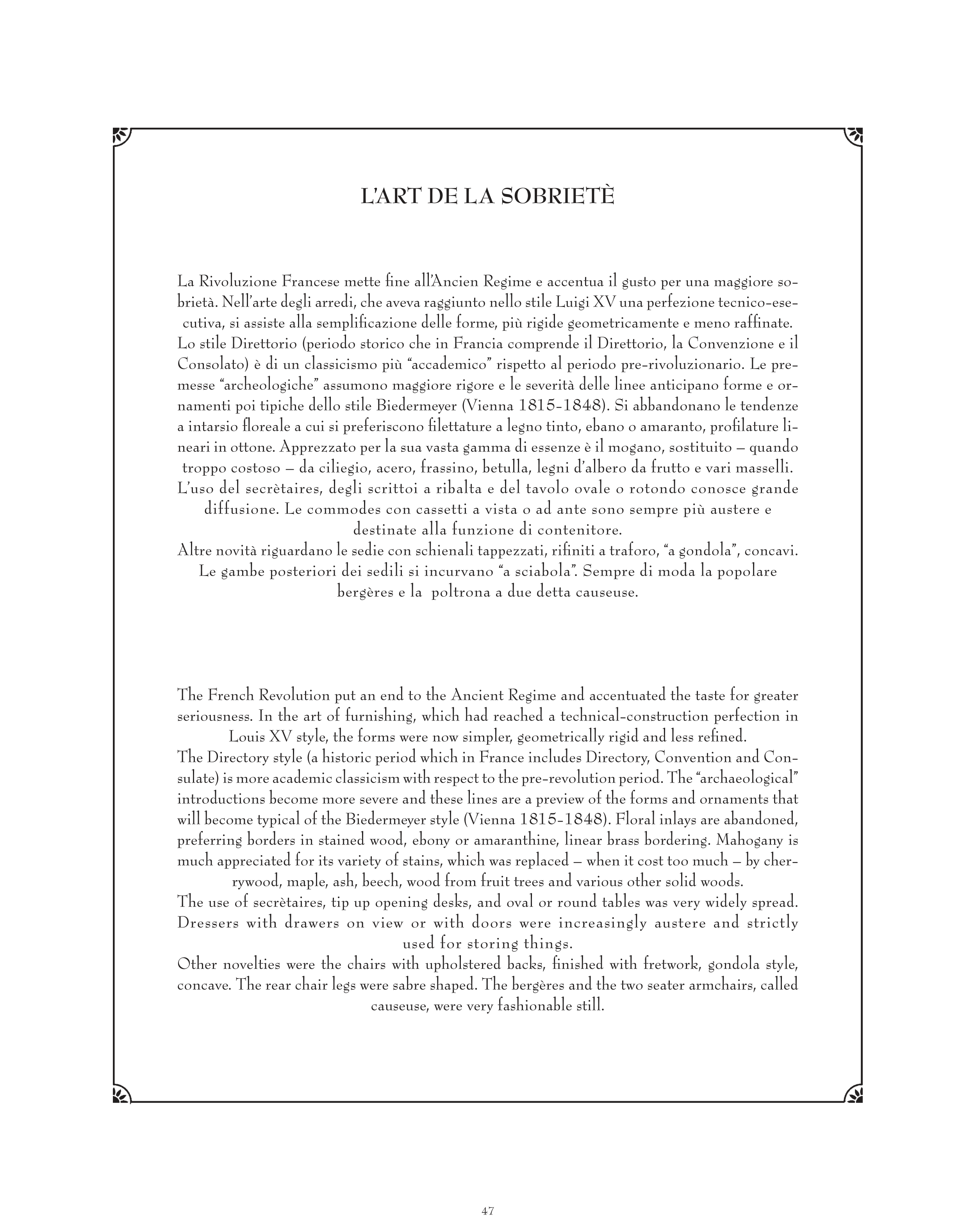L’ART DE LA SOBRIETÈ
La Rivoluzione Francese mette fi ne all’Ancien Regime e accentua il gusto per una maggiore so-
brietà. Nell’arte degli arredi, che aveva raggiunto nello stile Luigi XV una perfezione tecnico-ese-
cutiva, si assiste alla semplifi cazione delle forme, più rigide geometricamente e meno raffi nate.
Lo stile Direttorio (periodo storico che in Francia comprende il Direttorio, la Convenzione e il
Consolato) è di un classicismo più “accademico” rispetto al periodo pre-rivoluzionario. Le pre-
messe “archeologiche” assumono maggiore rigore e le severità delle linee anticipano forme e or-
namenti poi tipiche dello stile Biedermeyer (Vienna 1815-1848). Si abbandonano le tendenze
a intarsio fl oreale a cui si preferiscono fi lettature a legno tinto, ebano o amaranto, profi lature li-
neari in ottone. Apprezzato per la sua vasta gamma di essenze è il mogano, sostituito – quando
troppo costoso – da ciliegio, acero, frassino, betulla, legni d’albero da frutto e vari masselli.
L’uso del secrètaires, degli scrittoi a ribalta e del tavolo ovale o rotondo conosce grande
diffusione. Le commodes con cassetti a vista o ad ante sono sempre più austere e
destinate alla funzione di contenitore.
Altre novità riguardano le sedie con schienali tappezzati, rifi niti a traforo, “a gondola”, concavi.
Le gambe posteriori dei sedili si incurvano “a sciabola”. Sempre di moda la popolare
bergères e la poltrona a due detta causeuse.
The French Revolution put an end to the Ancient Regime and accentuated the taste for greater
seriousness. In the art of furnishing, which had reached a technical-construction perfection in
Louis XV style, the forms were now simpler, geometrically rigid and less refi ned.
The Directory style (a historic period which in France includes Directory, Convention and Con-
sulate) is more academic classicism with respect to the pre-revolution period. The “archaeological”
introductions become more severe and these lines are a preview of the forms and ornaments that
will become typical of the Biedermeyer style (Vienna 1815-1848). Floral inlays are abandoned,
preferring borders in stained wood, ebony or amaranthine, linear brass bordering. Mahogany is
much appreciated for its variety of stains, which was replaced – when it cost too much – by cher-
rywood, maple, ash, beech, wood from fruit trees and various other solid woods.
The use of secrètaires, tip up opening desks, and oval or round tables was very widely spread.
Dressers with drawers on view or with doors were increasingly austere and strictly
used for storing things.
Other novelties were the chairs with upholstered backs, fi nished with fretwork, gondola style,
concave. The rear chair legs were sabre shaped. The bergères and the two seater armchairs, called
causeuse, were very fashionable still.
47


